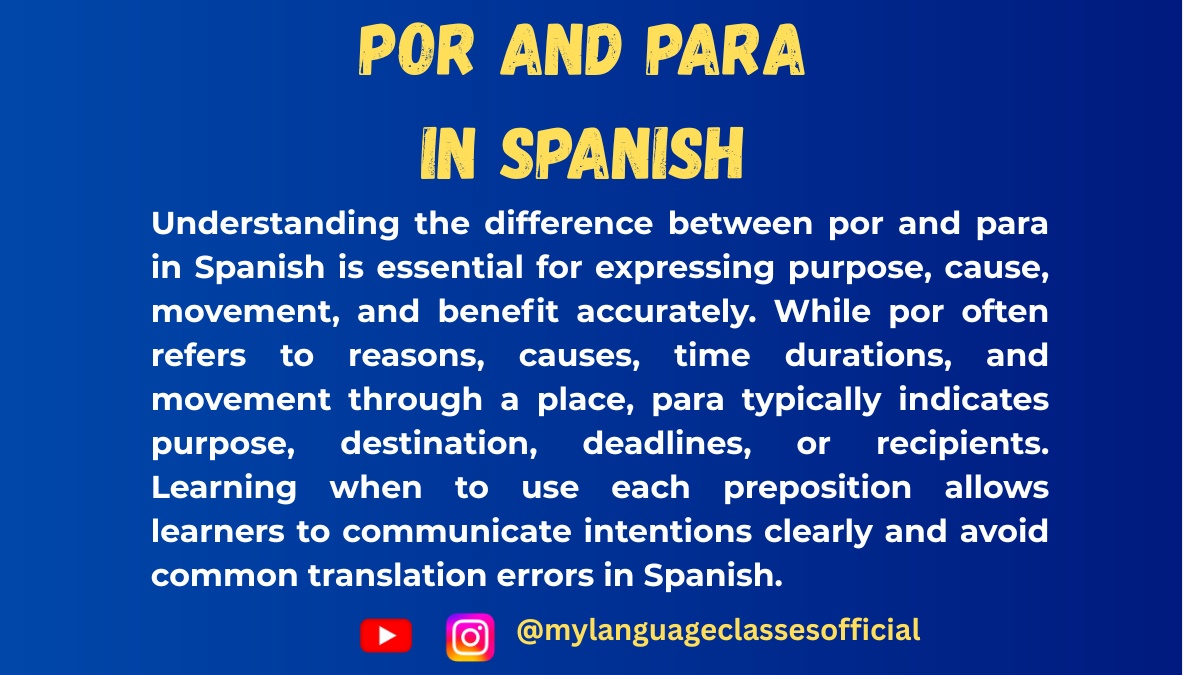Your cart is currently empty!
Tag: por para usage chart with examples
-

Por vs Para in Spanish
Mastering Por and Para in Spanish
One of the trickiest aspects of learning Spanish is understanding the difference between por and para. While they both translate to “for” in English, their meanings and applications differ significantly depending on the context. In this blog post, we’ll dive into their uses, provide practice questions, share tips for mastery, and conclude with insights to deepen your understanding.
The Basics of Por and Para
- Por: Often indicates cause, means, movement, or duration. Think of it as looking back at reasons or processes.
- Para: Focuses on purpose, destination, or goal. It looks forward to outcomes or effects.
Detailed Uses of Por
- Cause or Reason:
Indicates why something happens.- Por qué llegaste tarde? (Why were you late?)
- Llegué tarde por el tráfico. (I was late because of traffic.)
- Movement Through or Around:
Describes movement in a non-finalized way.- Caminamos por el parque. (We walked through the park.)
- Viajaron por Europa. (They traveled around Europe.)
- Means or Method:
Explains how something happens.- Te llamé por teléfono. (I called you by phone.)
- Mandé el paquete por correo. (I sent the package by mail.)
- Duration or Frequency:
Refers to how long or how often something occurs.- Estudié por tres horas. (I studied for three hours.)
- Voy al gimnasio dos veces por semana. (I go to the gym twice a week.)
- Exchange or Substitution:
Describes a trade or replacement.- Pagué veinte dólares por este libro. (I paid twenty dollars for this book.)
- Cambié mi auto viejo por uno nuevo. (I exchanged my old car for a new one.)
- Expressions of Emotion:
Highlights the cause of a feeling.- Tengo mucho respeto por ti. (I have a lot of respect for you.)
- Lo hizo por amor. (He did it out of love.)
- Idiomatic Expressions:
Learn these as set phrases:- Por favor (Please)
- Por supuesto (Of course)
- Por fin (Finally)
Detailed Uses of Para
- Purpose or Goal:
Focuses on the reason behind an action.- Estudio para ser doctor. (I study to become a doctor.)
- Trabajo para mejorar mi vida. (I work to improve my life.)
- Recipient:
Describes who benefits from an action.- Este regalo es para ti. (This gift is for you.)
- Hice este dibujo para mi mamá. (I made this drawing for my mom.)
- Deadlines:
Indicates time limits or expectations.- El proyecto es para mañana. (The project is due tomorrow.)
- Tenemos que estar listos para las 8. (We need to be ready by 8.)
- Destination:
Specifies where something is going.- Vamos para la playa. (We’re heading to the beach.)
- Salgo para Madrid esta noche. (I leave for Madrid tonight.)
- Opinion:
Used to express perspectives or preferences.- Para mí, es una buena idea. (In my opinion, it’s a good idea.)
- Para él, la tarea es difícil. (For him, the homework is hard.)
- Comparison to Standard:
Highlights unusual or unexpected qualities.- Para su edad, es muy madura. (For her age, she is very mature.)
- Para ser lunes, estoy de buen humor. (For a Monday, I’m in a good mood.)
Por vs. Para: Key Differences
- Time:
- Use por for duration (por tres horas – for three hours).
- Use para for deadlines (para mañana – for tomorrow).
- Movement:
- Use por for movement through a place (por el túnel – through the tunnel).
- Use para for destinations (para el hotel – to the hotel).
- Reason vs. Goal:
- Use por for reasons (por el mal tiempo – because of bad weather).
- Use para for goals (para aprender – to learn).
Practice Questions
- Translate:
- I bought this for my friend.
- We’ll be in Spain for two weeks.
- This book is for studying.
- They canceled the party because of the rain.
- Choose the correct preposition:
- Salgo ___ la escuela a las 7. (por/para)
- Hice esto ___ ti. (por/para)
- Gracias ___ venir. (por/para)
- Identify the context of por or para:
- ¿Por qué lo hiciste?
- Estudio para mejorar mi español.
Tips for Mastering Por and Para
- Think Cause vs. Purpose:
- Use por for reasons (past or present causes).
- Use para for goals or effects (future intentions).
- Visualize the Destination:
- Use para when thinking about a final result or destination.
- Memorize Idioms:
- Learn common expressions like por favor and para siempre.
- Practice in Context:
- Try to create sentences using both words to compare their meanings.
- Take Note of Patterns:
- Some verbs are almost always paired with por or para (e.g., gracias por, trabajar para).
Final Thoughts and Conclusion
Understanding the difference between por and para can feel challenging at first, but with practice, the nuances become clearer. Think of por as reflecting reasons, processes, or exchanges, while para points toward goals, outcomes, and destinations. By focusing on their key differences and practicing regularly, you’ll gain confidence in distinguishing them.
Both por and para are indispensable in Spanish, and mastering them will elevate your fluency. Use the practice questions, keep experimenting with sentences, and don’t shy away from making mistakes—learning a language is a journey of trial and discovery.
¡Buena suerte! (Good luck!)
If you found this guide helpful, I’d love to hear from you! Share your thoughts in the comments below or connect with me on social media. For more tips, resources, and inspiration, visit my blog at mylanguageclasses.in. Follow on Instagram and subscribe on YouTube
📚 Continue Learning Spanish
